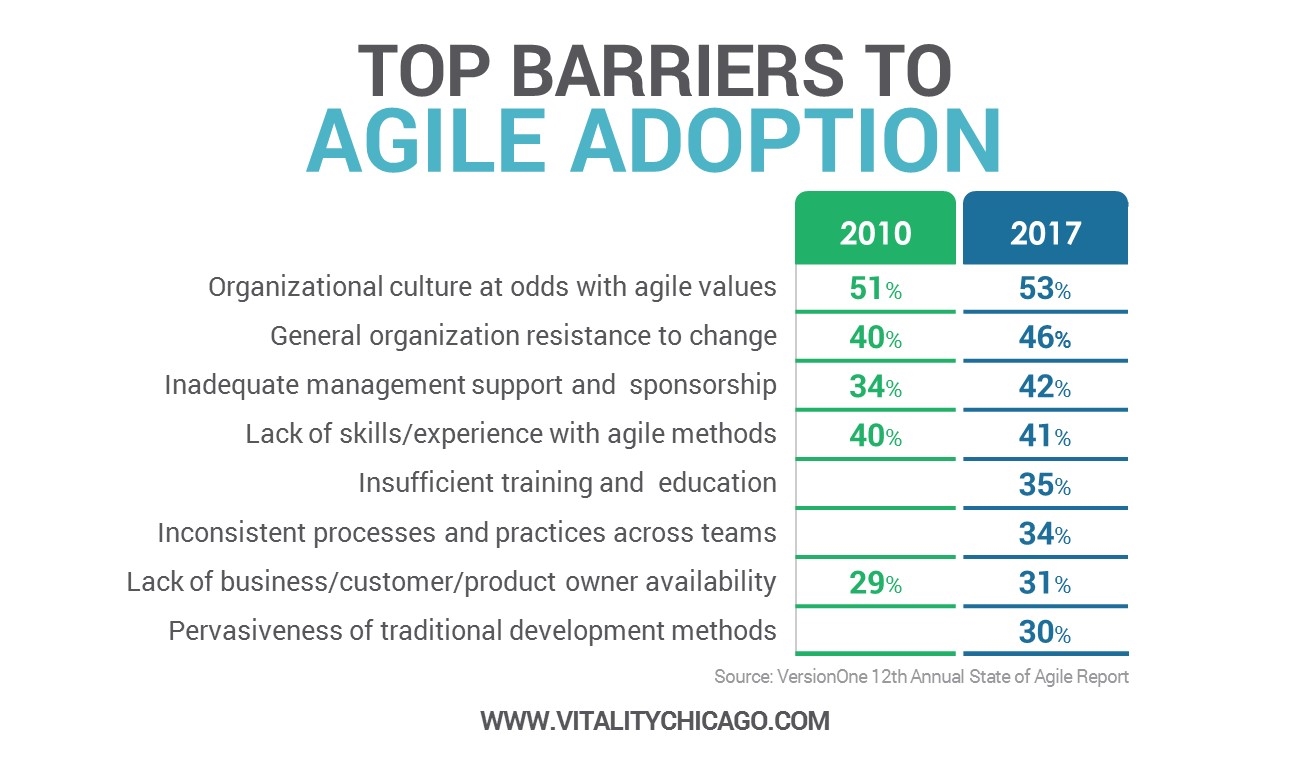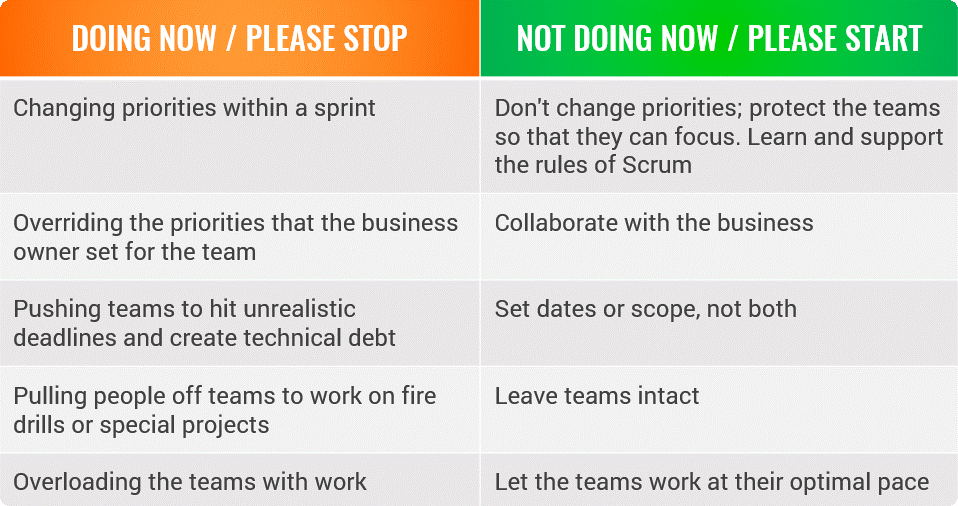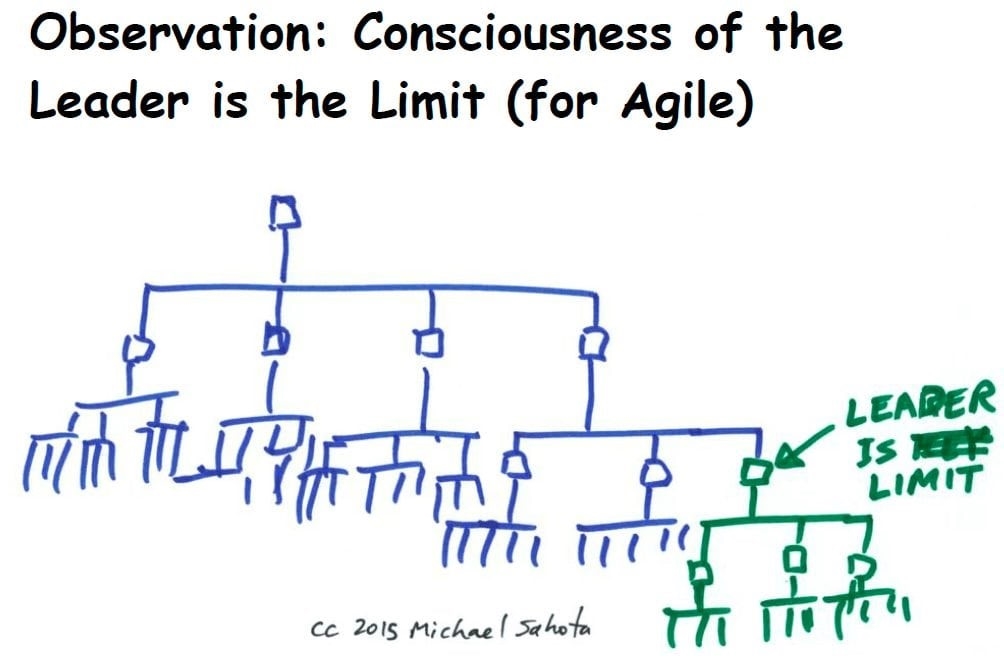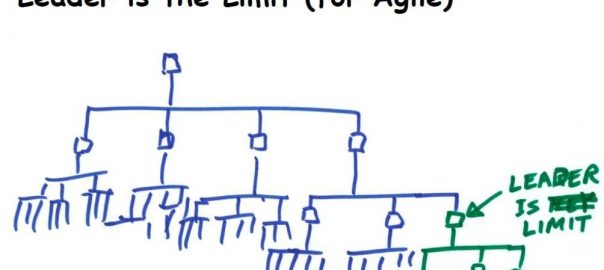In part 1 of this article, we looked at the definition of Agile Transformation and talked about the 4 key focus areas of Agile Leaders. In part 2 of this article, we will explore the Characteristics that Agile Leaders Need the Most. Finally, we discuss an uncomfortable truth that Leaders are often the impediment to agility in organizations. Team-based agility is actually easy and most teams take to it quickly because it makes sense and it helps them be more productive. For leaders, their experience may guide them to act in ways that actually run counter to agility.
What Characteristics Do Agile Leaders Need?
So, in addition to tenacity and grit, leaders need a clear why. But what other characteristics do they need? Reflecting on the great Agile leaders that I know, a few key leadership traits that come to mind are as follows.
- Growth Mindset
- Self-Awareness
- Ownership
- Humility
- Empathetic Listening Skills
- Courage and Risk Taking
- Trust
- Ability to See & Optimize the Whole
- Ability to Inspire Others
We will explore each of these further in the sections that follow.
Growth Mindset
Carol Dweck wrote about the growth mindset and fixed mindset in her 1995 book, Mindset. In short, the fixed mindset believes that intelligence is fixed and avoids making mistakes or other things that would lead to learning. The growth mindset acts as if anything can be learned and doesn’t fear making mistakes or revealing their ignorance.
Leaders with a growth mindset tend to experiment. They want to test and learn and then iterate quickly. They create an environment where it is safe to fail.
Self-Awareness
Leaders must be self-aware. This means that they are both aware of their strengths and weaknesses, but also aware of their emotional state. The emotions they bring to the individuals and teams they lead can either inspire or demoralize.
Ownership
Great leaders take personal responsibility for the outcomes and results they create. They don’t blame others when things don’t go their way, they reflect on it, learn from their experience, and try again. They see themselves as the authors of their experience and outcomes. Likewise, they refrain from blaming the people and teams they support.
Extreme ownership is the title of a recent book by former Navy Seal Jocko Willink. Willink writes about leadership and winning as a Navy Seal team. He coined the term “extreme ownership” based on the principle of taking personal responsibility for every outcome for the teams he led.
He rejected the idea that outside forces or people were to blame for what happened to his team. Rather than blame, he contends that great leaders take ownership for the results and learn from them.
When leaders take this type of ownership, they show that it is OK to make mistakes and fail occasionally. Teams that fail and recover are stronger than those that do not. It is only by making it safe to experiment will leaders unleash the innovation and creativity of their teams.
Humility
Great leaders keep their ego in check, are humble and open to feedback. They take in criticism and rather than defend, they demonstrate curiosity and openness. They are able to make self-effacing jokes.
Empathetic Listening Skills
Agile leaders tend to be great listeners who show empathy toward others. They don’t cut others off or interrupt. They make others feel valued. They show that they are able to empathize and put themselves in the shoes of others. They show that they genuinely care about people.
Courage and Risk Taking
Leaders need to demonstrate courage in the face of risks. As mentioned earlier, an Agile Transformation is a major program of change and that can be risky. Also, for agile teams to succeed, leaders need to create an environment where it is OK to fail and to learn. This can be risky in an organization that doesn’t have any tolerance for failure. (Which also means that organization doesn’t have a tolerance for learning).
Trust
The best Agile leaders empower and then trust the people that they lead. This particular characteristic ties directly to one of my favorite agile principles:
“Build projects around motivated individuals. Give them the environment and the support they need, and trust them to get the job done”
Great leaders also collaborate across the organization and build trust that reduces or eliminates silos and turf battles. They encourage and reward teamwork, rather than sowing dissention or creating an “us and them” mentality.
Ability to See & Optimize the Whole
A key lean principle is about avoiding sub-optimization. Great Agile Leaders have the ability to see the entire organization and focus on optimizing the whole, rather than one small part.
Ability to Inspire Others
A quick web search will show how popular it is to try and motivate others. There is a classic HBR article on this topic by Frederic Hertzberg called, One More time: How Do You Motivate Employees?
Motivating is the wrong approach. Today’s knowledge workers are motivated intrinsically, not extrinsically. Rather than trying to motivate others, we should provide the context for them to do their best work. And then leaders focus on inspiring others, especially when it comes to change.
Leaders May be the Biggest Impediment to Agile Transformation
You may find it surprising that Managers and Leaders are often the biggest impediment to transformation. It is an interesting conundrum – managers and leaders say they want to be more Agile, yet they are often the ones who hinder adoption or transformation. It is a lot like me saying that I want to get 6 pack abs but I don’t want to exercise or eat healthy food. What I say is not aligned with my actions.
So why do I say that managers are putting on the brakes on Agile? Well, first it’s because it is what I’ve seen happen at one organization after another. Managers and leaders control what is happening – directly or indirectly.
Second, surveys say so. The VersionOne Annual State of Agile Report in particular has a question about barriers to further Agile adoption. Respondents continue to point to the leadership when it comes to inhibiting agile adoption.
The chart below compares the responses from the 12th Annual Report conducted in 2017, and the responses collected in 2010. It is interesting to look at the “barriers” identified by organizations and how they all relate to the leadership. It is also interesting that the results have changed little over the last 5 years. If anything, the barriers that managers are putting up are even higher than before.

A True Story about Agile Transformation
I met with some of the agile transformation champions at a client recently and they asked for my help. They were striving to lead agility in their organization and were supporting their teams to improve and mature their practices. Unfortunately, they found that their teams had hit a brick wall and were not progressing.
That brick wall was the executive leadership team. The management team said they wanted the benefits of Agile but frequently acted in ways that undercut the agile teams. The attitude of the leadership team seems to be, “we’ll tolerate Agile as long as everyone meets the deadlines and gets all the work done”.
We’ll tolerate Agile as long as everyone meets the deadlines and gets all the work done.
Does that sound Agile or effective to you? More importantly, does it sound familiar?
The champions team wanted to enroll my help to make a fact and data-based argument. They wanted the executive leadership team to change the way they were behaving to be more Agile friendly; to stop doing some things and start doing others.
A Stop Doing and Start Doing List for Leadership
Here is the list of items that they wanted the leadership to stop doing, and the corresponding list of items that they wanted the leadership to start doing.
HAZEL – Please add the following to the table above, not just for the new articles but for the already published one on our site.
Stop: Pretend to know all about Agile though you have no training or experience
START: Get Agile training

Are Leaders too busy for Transformation?
In the previous example, I think leaders were just too busy to focus on transformation. Most leaders are under pressure to do more with less and to show short-term results. Agile transformation is a long-term investment. Most executives don’t have the time to wait for Agile teams to develop or to learn how to best support an Agile team.
Or is it that Leaders Just Don’t Understand Transformation?
I don’t think most leaders really understand transformation. Few leaders take the time to attend Agile training. Most already know all about agile (sigh) and so don’t believe they need any Agile or Scrum training (though in reality, they do need Agile Training). They espouse Agile and give it lip service, but they don’t effectively support it. Nor do they live it.
These leaders are governing how much growth the teams will have. The teams are only going to be able to mature to a certain point and then they will hit the wall.
It’s a recognizable enough pattern that Agile Transformation expert Michael Sahota talked about it in my recent Certified Agile Leader Course (which I highly recommend, BTW). He said that:
The Consciousness of the Leader is the Limit (for Agile)
— Michael Sahota

Michael was probably inspired by what Frederic Laloux said in his book Re-Inventing Organizations:
The general rule seems to be that the level of consciousness of an organization cannot exceed the level of consciousness of its leader.
— Frederic Laloux
This rule that the leader is the limit to development in organizations has a couple of powerful implications:
If the leadership team is not on board, there is little that individuals on the lower rungs of the organization can do to make agile stick or for an effective Agile Transformation.
If you want to make a major change in an organization, like Agile Transformation, the leadership team needs to understand and champion the change.
Literally, agile transformation leaders need to go in front of the change. They do this by investing in their own Agile learning and growth.
Next Steps for Agile Transformation Leaders
If you are a leader who wants to gain the benefits of business agility, flexibility, and team productivity, it is within your reach. Though we recognize that an Agile Transformation is not easy or painless, it is within your power to help Agile succeed. The way out is to lead through the change, and go first with your own transformation.
This 2-part article originally appeared on Vitality Chicago’s Blog and has been republished with permission.
Business & Finance Articles on Business 2 Community
(66)
Report Post








